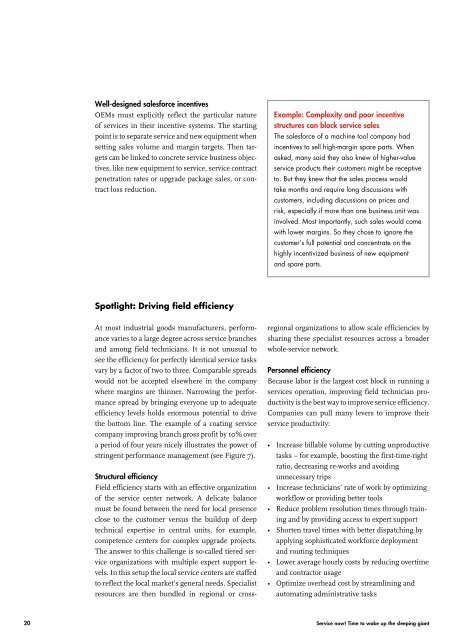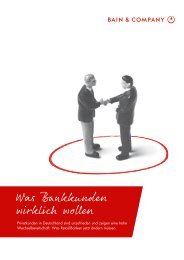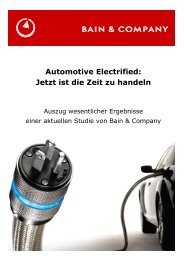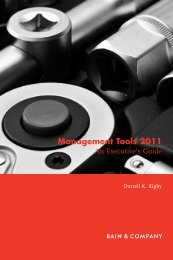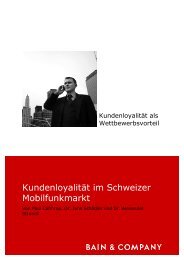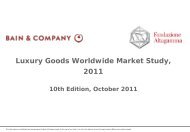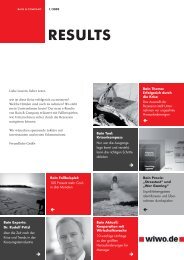Service now! Time to wake up the sleeping giant - Bain & Company
Service now! Time to wake up the sleeping giant - Bain & Company
Service now! Time to wake up the sleeping giant - Bain & Company
Create successful ePaper yourself
Turn your PDF publications into a flip-book with our unique Google optimized e-Paper software.
Well-designed salesforce incentives<br />
OEMs must explicitly reflect <strong>the</strong> particular nature<br />
of services in <strong>the</strong>ir incentive systems. The starting<br />
point is <strong>to</strong> separate service and new equipment when<br />
setting sales volume and margin targets. Then targets<br />
can be linked <strong>to</strong> concrete service business objectives,<br />
like new equipment <strong>to</strong> service, service contract<br />
penetration rates or <strong>up</strong>grade package sales, or contract<br />
loss reduction.<br />
Spotlight: driving field efficiency<br />
At most industrial goods manufacturers, performance<br />
varies <strong>to</strong> a large degree across service branches<br />
and among field technicians. It is not unusual <strong>to</strong><br />
see <strong>the</strong> efficiency for perfectly identical service tasks<br />
vary by a fac<strong>to</strong>r of two <strong>to</strong> three. Comparable spreads<br />
would not be accepted elsewhere in <strong>the</strong> company<br />
where margins are thinner. Narrowing <strong>the</strong> performance<br />
spread by bringing everyone <strong>up</strong> <strong>to</strong> adequate<br />
efficiency levels holds enormous potential <strong>to</strong> drive<br />
<strong>the</strong> bot<strong>to</strong>m line. The example of a coating service<br />
company improving branch gross profit by 10% over<br />
a period of four years nicely illustrates <strong>the</strong> power of<br />
stringent performance management (see Figure 7).<br />
Structural efficiency<br />
Field efficiency starts with an effective organization<br />
of <strong>the</strong> service center network. A delicate balance<br />
must be found between <strong>the</strong> need for local presence<br />
close <strong>to</strong> <strong>the</strong> cus<strong>to</strong>mer versus <strong>the</strong> build<strong>up</strong> of deep<br />
technical expertise in central units, for example,<br />
competence centers for complex <strong>up</strong>grade projects.<br />
The answer <strong>to</strong> this challenge is so-called tiered service<br />
organizations with multiple expert s<strong>up</strong>port levels.<br />
In this set<strong>up</strong> <strong>the</strong> local service centers are staffed<br />
<strong>to</strong> reflect <strong>the</strong> local market’s general needs. Specialist<br />
resources are <strong>the</strong>n bundled in regional or cross-<br />
Example: Complexity and poor incentive<br />
structures can block service sales<br />
The salesforce of a machine <strong>to</strong>ol company had<br />
incentives <strong>to</strong> sell high-margin spare parts. When<br />
asked, many said <strong>the</strong>y also knew of higher-value<br />
service products <strong>the</strong>ir cus<strong>to</strong>mers might be receptive<br />
<strong>to</strong>. But <strong>the</strong>y knew that <strong>the</strong> sales process would<br />
take months and require long discussions with<br />
cus<strong>to</strong>mers, including discussions on prices and<br />
risk, especially if more than one business unit was<br />
involved. Most importantly, such sales would come<br />
with lower margins. So <strong>the</strong>y chose <strong>to</strong> ignore <strong>the</strong><br />
cus<strong>to</strong>mer’s full potential and concentrate on <strong>the</strong><br />
highly incentivized business of new equipment<br />
and spare parts.<br />
regional organizations <strong>to</strong> allow scale efficiencies by<br />
sharing <strong>the</strong>se specialist resources across a broader<br />
whole-service network.<br />
Personnel efficiency<br />
Because labor is <strong>the</strong> largest cost block in running a<br />
services operation, improving field technician productivity<br />
is <strong>the</strong> best way <strong>to</strong> improve service efficiency.<br />
Companies can pull many levers <strong>to</strong> improve <strong>the</strong>ir<br />
service productivity:<br />
• Increase billable volume by cutting unproductive<br />
tasks – for example, boosting <strong>the</strong> first-time-right<br />
ratio, decreasing re-works and avoiding<br />
unnecessary trips<br />
• Increase technicians’ rate of work by optimizing<br />
workflow or providing better <strong>to</strong>ols<br />
• Reduce problem resolution times through training<br />
and by providing access <strong>to</strong> expert s<strong>up</strong>port<br />
• Shorten travel times with better dispatching by<br />
applying sophisticated workforce deployment<br />
and routing techniques<br />
• Lower average hourly costs by reducing overtime<br />
and contrac<strong>to</strong>r usage<br />
• Optimize overhead cost by streamlining and<br />
au<strong>to</strong>mating administrative tasks<br />
20 <strong>Service</strong> <strong>now</strong>! <strong>Time</strong> <strong>to</strong> <strong>wake</strong> <strong>up</strong> <strong>the</strong> <strong>sleeping</strong> <strong>giant</strong>


